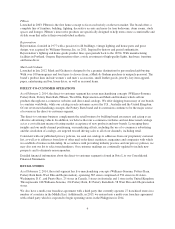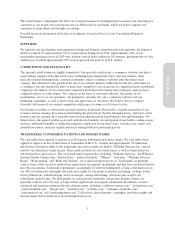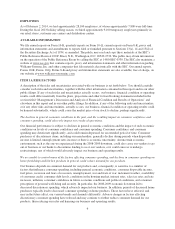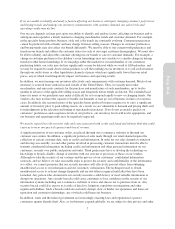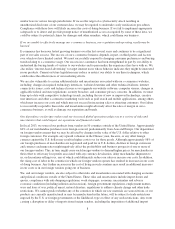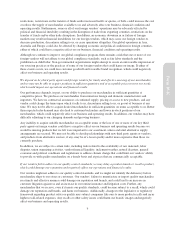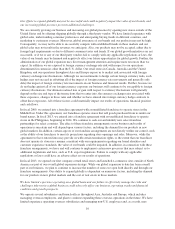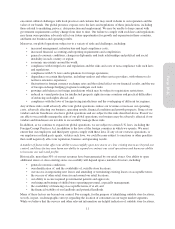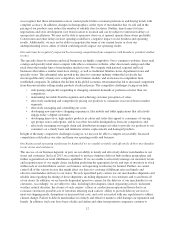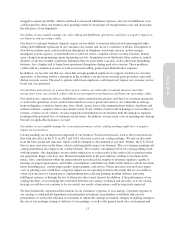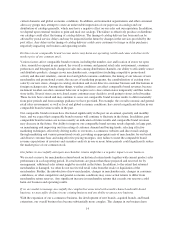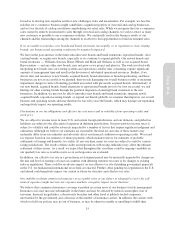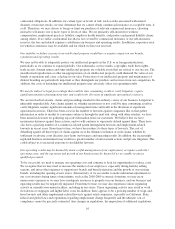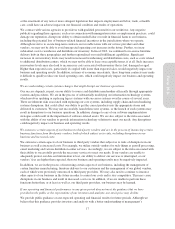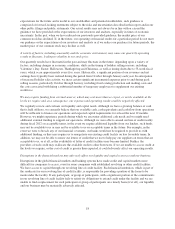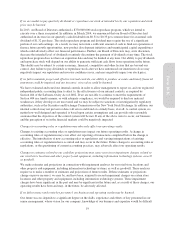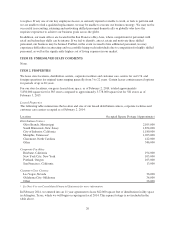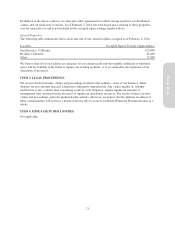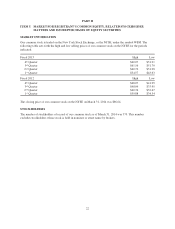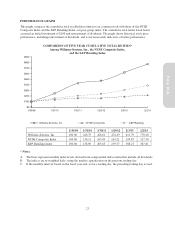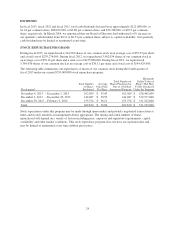Pottery Barn 2013 Annual Report Download - page 28
Download and view the complete annual report
Please find page 28 of the 2013 Pottery Barn annual report below. You can navigate through the pages in the report by either clicking on the pages listed below, or by using the keyword search tool below to find specific information within the annual report.current domestic and global economic conditions. In addition, environmental organizations and other consumer
advocacy groups may attempt to create an unfavorable impression of our paper use in catalogs and our
distribution of catalogs generally, which may have a negative effect on our sales and our reputation. In addition,
we depend upon external vendors to print and mail our catalogs. The failure to effectively produce or distribute
our catalogs could affect the timing of catalog delivery. The timing of catalog delivery has been and can be
affected by postal service delays and may be impacted in the future by changes in the services provided by the
post office. Any delays in the timing of catalog delivery could cause customers to forego or defer purchases,
negatively impacting our business and operating results.
Declines in our comparable brand revenue metric may harm our operating results and cause a decline in the
market price of our common stock.
Various factors affect comparable brand revenues, including the number, size and location of stores we open,
close, remodel or expand in any period, the overall economic and general retail sales environment, consumer
preferences and buying trends, changes in sales mix among distribution channels, our ability to efficiently source
and distribute products, changes in our merchandise mix, competition (including competitive promotional
activity and discount retailers), current local and global economic conditions, the timing of our releases of new
merchandise and promotional events, the success of marketing programs, the cannibalization of existing store
sales by our new stores, changes in catalog circulation and in our direct-to-customer business and fluctuations in
foreign exchange rates. Among other things, weather conditions can affect comparable brand revenues because
inclement weather can alter consumer behavior or require us to close certain stores temporarily and thus reduce
store traffic. Even if stores are not closed, many customers may decide to avoid going to stores in bad weather.
These factors have caused and may continue to cause our comparable brand revenue results to differ materially
from prior periods and from earnings guidance we have provided. For example, the overall economic and general
retail sales environment, as well as local and global economic conditions, has caused a significant decline in our
comparable brand revenue results in the past.
Our comparable brand revenues have fluctuated significantly in the past on an annual, quarterly and monthly
basis, and we expect that comparable brand revenues will continue to fluctuate in the future. In addition, past
comparable brand revenues are not necessarily an indication of future results and comparable brand revenues
may decrease in the future. Our ability to improve our comparable brand revenue results depends, in large part,
on maintaining and improving our forecasting of customer demand and buying trends, selecting effective
marketing techniques, effectively driving traffic to our stores, e-commerce websites and direct mail catalogs
through marketing and various promotional events, providing an appropriate mix of merchandise for our broad
and diverse customer base and using effective pricing strategies. Any failure to meet the comparable brand
revenue expectations of investors and securities analysts in one or more future periods could significantly reduce
the market price of our common stock.
Our failure to successfully anticipate merchandise returns might have a negative impact on our business.
We record a reserve for merchandise returns based on historical return trends together with current product sales
performance in each reporting period. If actual returns are greater than those projected and reserved for by
management, additional sales returns might be recorded in the future. In addition, to the extent that returned
merchandise is damaged, we often do not receive full retail value from the resale or liquidation of the
merchandise. Further, the introduction of new merchandise, changes in merchandise mix, changes in consumer
confidence, or other competitive and general economic conditions may cause actual returns to differ from
merchandise return reserves. Any significant increase in merchandise returns that exceeds our reserves could
harm our business and operating results.
If we are unable to manage successfully the complexities associated with a multi-channel and multi-brand
business, we may suffer declines in our existing business and our ability to attract new business.
With the expansion of our e-commerce business, the development of new brands, acquired brands, and brand
extensions, our overall business has become substantially more complex. The changes in our business have
14


